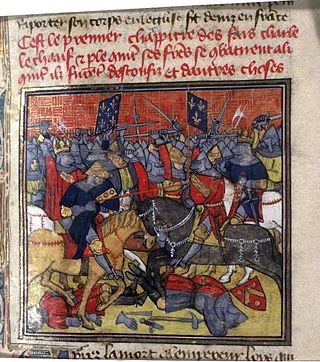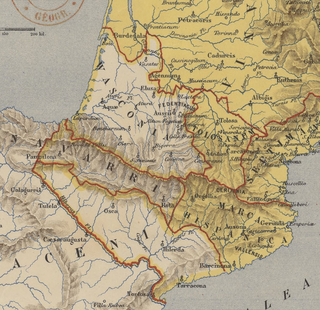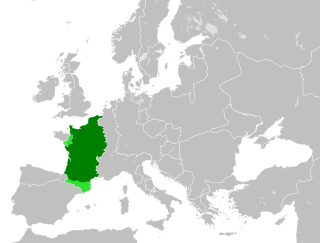Related Research Articles

Charles the Bald, also known as Charles II, was a 9th-century king of West Francia (843–877), King of Italy (875–877) and emperor of the Carolingian Empire (875–877). After a series of civil wars during the reign of his father, Louis the Pious, Charles succeeded, by the Treaty of Verdun (843), in acquiring the western third of the empire. He was a grandson of Charlemagne and the youngest son of Louis the Pious by his second wife, Judith.

The three-year Carolingian Civil War culminated in the decisive Battle of Fontenoy, also called the Battle of Fontenoy-en-Puisaye, fought at Fontenoy, near Auxerre, on 25 June 841. The war was fought to decide the territorial inheritances of Charlemagne's grandsons—the division of the Carolingian Empire among the three surviving sons of Louis the Pious. Despite Louis' provisions for succession, war broke out between his sons and nephews. The battle has been described as a major defeat for the allied forces of Lothair I of Italy and Pepin II of Aquitaine, and a victory for Charles the Bald and Louis the German. Hostilities dragged on for another two years until the Treaty of Verdun, which had a major influence on subsequent European history.

Lothair I was a 9th-century Carolingian emperor and king of Italy (818–855) and Middle Francia (843–855).

Septimania is a historical region in modern-day southern France. It referred to the western part of the Roman province of Gallia Narbonensis that passed to the control of the Visigoths in 462, when Septimania was ceded to their king, Theodoric II. During the Early Middle Ages, the region was variously known as Gallia Narbonensis, Gallia, or Narbonensis. The territory of Septimania roughly corresponds with the modern French former administrative region of Languedoc-Roussillon that merged into the new administrative region of Occitanie. In the Visigothic Kingdom, which became centred on Toledo by the end of the reign of Leovigild, Septimania was both an administrative province of the central royal government and an ecclesiastical province whose metropolitan was the Archbishop of Narbonne. Originally, the Goths may have maintained their hold on the Albigeois, but if so it was conquered by the time of Chilperic I. There is archaeological evidence that some enclaves of Visigothic population remained in Frankish Gaul, near the Septimanian border, after 507.

The Kingdom of the Franks, also known as the Frankish Kingdom, the Frankish Empire or Francia, was the largest post-Roman barbarian kingdom in Western Europe. It was ruled by the Frankish Merovingian and Carolingian dynasties during the Early Middle Ages. Francia was among the last surviving Germanic kingdoms from the Migration Period era.

The Duchy of Aquitaine was a historical fiefdom located in the western, central and southern areas of present-day France, south of the river Loire. Although the full extent of the duchy, as well as its name, fluctuated greatly over the centuries and at times comprised much of what is now southwestern (Gascony) and central France.

Nominoe or Nomenoe was the first Duke of Brittany from 846 to his death. He is the Breton pater patriae and to Breton nationalists he is known as Tad ar Vro.

The Spanish March or Hispanic March was a march or military buffer zone established c. 795 by Charlemagne in the eastern Pyrenees and nearby areas, to protect the new territories of the Christian Carolingian Empire—the Duchy of Gascony, the Duchy of Aquitaine, and Septimania—from the Muslim Umayyad Emirate of Córdoba in al-Andalus.
Bernardof Septimania (795–844), son of William of Gellone and cousin of Charlemagne, was the Duke of Septimania and Count of Barcelona from 826 to 832 and again from 835 to his execution, and also Count of Carcassonne from 837. He was appointed to succeed the third Count of Barcelona, Rampon. During his career, Bernard was one of the closest counsellors of the Emperor Louis the Pious, a leading proponent of the war against the Moors, and was an opponent of the interests of the local Visigothic nobility in Iberia.
Berengar, called the Wise, was the duke or count of Toulouse (814–835) and duke of Septimania (832–835). He held the County of Barcelona concomitantly with Septimania.

Sunifred was the Count of Urgell and Cerdanya from 834 to 848, and the Count of Barcelona as well as many other Catalan and Septimanian counties, including Ausona, Besalú, Girona, Narbonne, Agde, Béziers, Lodève, Melgueil, Conflent and Nîmes, from 844 to 848.

Pepin II, called the Younger, was King of Aquitaine from 838 as the successor upon the death of his father, Pepin I. Pepin II was eldest son of Pepin I and Ingeltrude, daughter of Theodobert, count of Madrie. He was a grandson of the Emperor Louis the Pious.

In medieval historiography, West Francia or the Kingdom of the West Franks constitutes the initial stage of the Kingdom of France and extends from the year 843, from the Treaty of Verdun, to 987, the beginning of the Capetian dynasty. It was created from the division of the Carolingian Empire following the death of Louis the Pious, with its neighbor East Francia eventually evolving into the Kingdom of Germany.
William of Septimania was the son of Bernard and Dhuoda. He was the count of Toulouse from 844 and count of Barcelona from 848.
Austrovald, Astrobald, and Austrevald was the Duke of Aquitaine from 587.
Guerin, Garin, Warin, or Werner was the Count of Auvergne, Chalon, Mâcon, Autun, Arles and Duke of Provence, Burgundy, and Toulouse. Guerin established the region against the Saracens from a base of Marseille and fortified Chalon-sur-Saône (834). He took part in many campaigns during the civil wars that marked the reign of Louis the Pious (814–840) and after his death until the Treaty of Verdun (843). The primary sources for his life are charters and chronicles like the Vita Hludovici.
Acfred was the Count of Toulouse from 842 to 843. When Charles the Bald deposed Bernard of Septimania in 842, he installed Acfred in Toulouse in July. The next year, however, Bernard, allied with Pepin II of Aquitaine, expelled Acfred. He never regained his country. Acfred's deposition was not recognised by the king until 844 or 845, when, having defeated and executed Bernard, he appointed Fredelon count of Toulouse. Perhaps Acfred had died by then, but perhaps not.
The Duchy of Alsace was a large political subdivision of the Frankish Empire during the last century and a half of Merovingian rule. It corresponded to the territory of Alsace and was carved out of southern Austrasia in the last decade of the reign of Dagobert I, probably to stabilise the southern reaches of Austrasia against Alemannia and Burgundy. By the late Middle Ages, the region was considered part of Swabia.
Ekkehard (Eggebard) (d. 844), Count of Hesbaye, possibly son of Nibelung, Count of the Vexin, and grandson of Childebrand I of Herstal. Ekkehard was a vassal of Louis the Pious. Ekkehard apparently assumed the title of Count of Hesbaye upon the death of Robert II, although the circumstances of this transition are unknown. Ekkehard may be related to Count Meginhare.
References
- ↑ Bury, J. B. (1922). The Cambridge Medieval History, Volume III: Germany and the Western Empire. Manchester: Manchester University Press. p. 31.
- ↑ Lewis, A. (1976). The Dukes in the Regnum Francorum, A.D. 550-751. Speculum, 51(3), 381-410
- ↑ Brooke, Z. N. (Zachary Nugent)., Previté-Orton, C. W. (Charles William)., Tanner, J. R. (Joseph Robson)., Whitney, J. Pounder., Gwatkin, H. Melvill., Bury, J. B. (John Bagnell). (19111936). The Cambridge medieval history. New York: Macmillan.